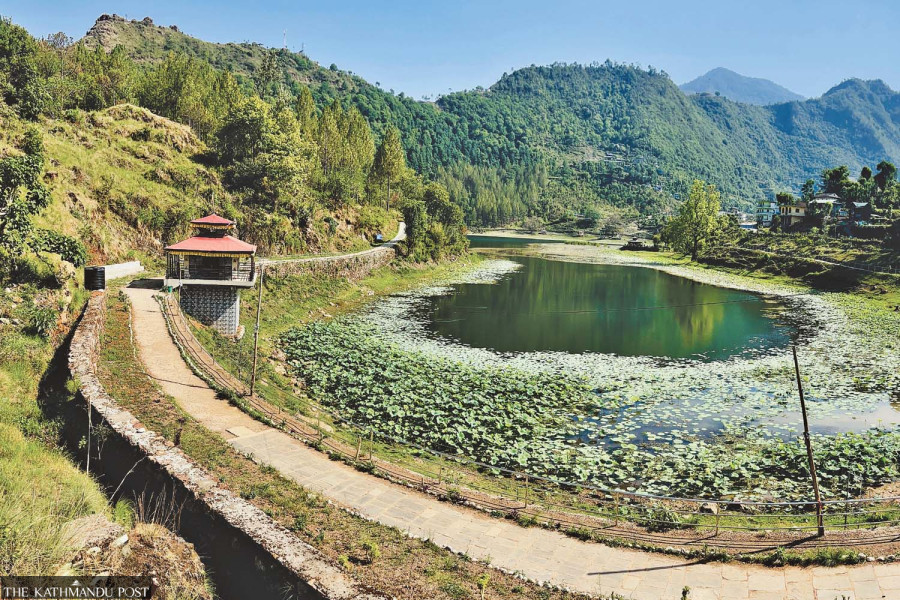Lumbini Province
Locals worried as water recedes in scenic lotus pond
Government official attributes water level decline to haphazard infrastructure development on watershed areas and prolonged drought.
Mahesh KC
Rishiram Upadhyaya, aged 69, of Takura in ward 5 of Sisne Rural Municipality has been surprised by the recent drop in water level of the local pond. The pond is named Kamaltal, meaning the pond of lotuses, due to its abundance of aquatic plants with interesting leaves and stunning flowers. Local residents like Upadhyaya are quite worried as the lake is shrinking.
Known as the district of Baunna Pokhari Tripanna Takuri (place of 52 ponds and 53 hills), Rukum—now divided into Rukum East and Rukum West for the federal ruling system—has many scenic lakes and ponds. Among them is Kamaltaal, which is located at ward 5 of Sisne Rural Municipality in Rukum East, a hill district in Lumbini Province.
The pond, spreading in around 1.95 square kilometers, is one of the major tourist destinations in Rukum East. However, with its water level gradually dwindling, the lotus plants started drying up. “The water level is gradually decreasing over the past few years in the lake. But we have not seen the lotuses dry up like they have this year,” said Upadhyaya.
This naturally beautiful pond, which lies near the Mid-Hill Highway, has religious significance as well. There are temples of Baraha and Nag-Nagin (serpent deities) on its bank. “It is believed that Lord Vishnu took shelter here in ancient times. The locals offer pooja at the pond as a revered place,” said Madan Shah, another local.

Kamaltal is surrounded by a forest in the north and the east while there is human settlement to the south and the west. The pond was not fenced until a few years ago. “The quadrupeds quenched their thirst in the pond and people also used the water. The pond was once full of water and lotus flowers. The lotuses would start blooming around this time. Now both the water level and flowers have decreased,” said Krishna Devi Thapa, a local woman from ward 5 of Sisne. According to her, far fewer lotus plants are growing in the pond this year.
It is believed that Kamaltal does not have any permanent source of water and is instead filled by rainwater during the monsoon. Jitendra Khadka, chief at the Division Forest Office in Rukum East, said the pond’s water level has decreased due to increasing human activities and haphazard construction of various infrastructures in the area.
“The construction of various infrastructures in the watershed areas of the pond and the foot trail around the water body has caused the water level to decrease. The problem is particularly severe this year, possibly due to the long drought,” said Khadka. He suggests that the pond should be refilled by identifying perennial water sources.
Sisne Rural Municipality also expressed concerns regarding the dwindling water and flowers in the pond. “We are seeking alternatives to refill the pond as its water level is decreasing. We are committed to preserving the pond,” said Gopal Reule, the vice-chairman of the local unit.
Efforts are on to bring water from Ghangaruchaur by installing a 150 mm pipe through the Irrigation Sub-Division Office. The office had allocated a total of Rs4 million for the work in the last fiscal year and the current fiscal year. “All the necessary work has been completed on our end. But water could not be supplied to the pond due to protests by the residents of Ghangaruchaur area,” said Madan Prasad Shah, chief at the sub-division office.
According to the rural municipality, the people’s representatives are currently holding talks with the protesting locals of Ghangaruchaur to resolve the issue. “We are making progress towards addressing the demands of the protesters and bringing water from Ghangaruchaur,” said Reule.
The local residents are concerned about the protection of Kamaltal and other lakes and ponds in Rukum. They have urged the local, provincial and the federal governments as well as the authorities concerned to protect the lakes and ponds from extinction as they represent the identity of the district.




 5.12°C Kathmandu
5.12°C Kathmandu












